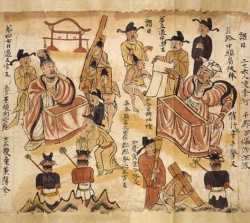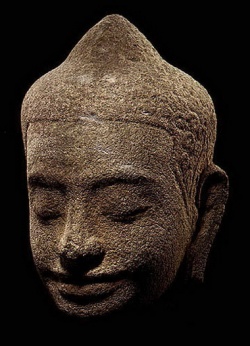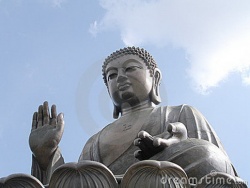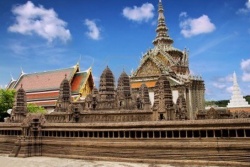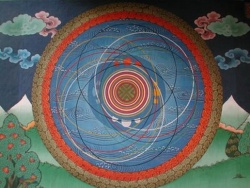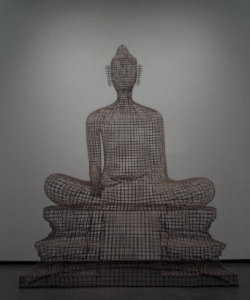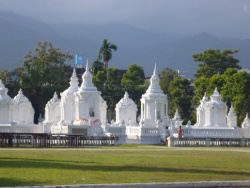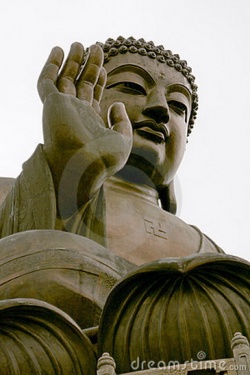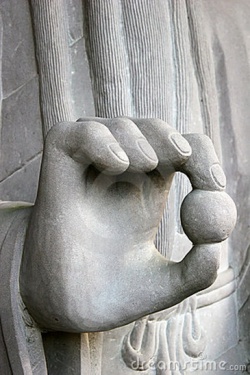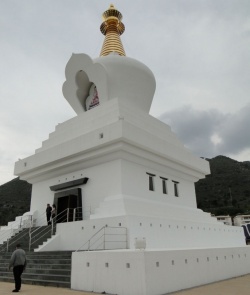Madhyamaka
Madhyamaka (Wyl. dbu ma) refers to both the state of the Middle Way, which is the freedom from all extremes, as it is said in the Samadhiraja Sutra:
"Existence and non-existence are extremes,
Purity and impurity are extremes as well,
Thus, having relinquished both extremes,
The wise do not dwell even in the middle."
Madhyamaka also refers to the texts that express this ultimate meaning such as the Mulamadhyamaka-karika by Nagarjuna.
The meaning expressed by the term Madhyamaka is, we could say, the sphere of reality (dharmadhatu), beyond all extremes.
This can then be further divided into:
- the Ground Madhyamaka, the unity of the two truths;
- the Path Madhyamaka, the unity of skilful means and wisdom; and
- the Fruition Madhyamaka, the unity of the two kayas.
These are all beyond extremes:
- The Ground Madhyamaka, the unity of the two truths, is beyond all extremes because it is beyond the extremes of eternalism and nihilism.
- The Path Madhyamaka, the unity of skilful means and wisdom, is beyond the extremes of exaggeration and denial.
- The Fruition Madhyamaka, the unity of the two kayas, is beyond the extremes of samsaric existence and the peace of nirvana.
See also Madhyamika for the Middle Way philosophical tenet system and its followers.
Oral Teachings Given to the Rigpa Sangha
- Khenpo Tsultrim Gyamtso Rinpoche, May 1982, London, St Paul’s Crescent, 'Madhyamaka, Philosophy in Practise'.
Madhyamaka (Sanskrit: मध्यमक, Madhyamaka, Chinese: 中觀派; pinyin: Zhōngguān Pài; also known as Śūnyavāda) refers primarily to a Mahāyāna Buddhist school of philosophy[1] founded by Nāgārjuna. The school of thought and its subsidiaries are called "Madhyamaka"; those who follow it are called "Mādhyamikas". According to Madhyamaka all phenomena are empty of "substance" or "essence" (Sanskrit: svabhāva) because they are dependently co-arisen. Likewise it is because they are dependently co-arisen that they have no intrinsic, independent reality of their own.
Whatever is dependent arising We declared that to be emptiness. That is dependent designation, And is itself the middle way. ”
—Nāgārjuna, Mūlamadhyamakakārikā 24:18
Origins and development
Nagarjuna
The Madhyamaka school is usually considered to have been founded by Nāgārjuna, though it may have existed earlier. The name of the school is perhaps related to its close adherence to Nāgārjuna’s main work, the Mūlamadhyamakakārikā. The term Madhyamaka is related to 'madhya' ('the middle').
The Madhyamaka school has been perhaps simplistically regarded as a reaction against the development of the Abhidharma, especially the Sarvāstivādin.
In the Abhidharma, dharmas are characterized by defining traits (lakṣaṇa) or own-existence (svabhāva), whose ontological status is not dependent upon concepts.
The problem with the Abidharma is not that things are 'independently existent' (a position that most Abhidharma schools would not accept), but rather (from a Madhyamaka perspective) that they are independent from notions.
For the Madhyamaka, dharmas are notionally dependent, and further more, their notional dependence entails existential dependence and hence lack of ultimate, true existence.
The relationship between Madhyamaka and Abhidharma is complex; Abhidharmic analysis figures prominently in most Madhyamaka treatises, and authoritative commentators like Candrakīrti emphasize that Abhidharmic categories function as a viable (and favored) system of conventional truths - they are more refined than ordinary categories, and they are not dependent on either the extreme of eternalism or on the extreme view of the discontinuity of karma, as the non-Buddhist categories of the time did.
It may be therefore important to understand that Madhyamaka constitutes a continuation of the Abhidharma type of analysis, extending the range of dependent arising to entail (and focus upon) notional dependence.
The dependent arising of concepts based on other concepts, rather than the true arising of really existent causes and effects, becomes here the matrix of any possible convention.
Prajñāpāramitā
Madhyamaka thought is also closely related to a number of Mahāyāna sources; traditionally, the Prajñāpāramitāsūtras are the literature most closely associated with Madhyamaka – understood, at least in part, as an exegetical complement to those Sūtras.
Traditional accounts also depict Nāgārjuna as retrieving some of the larger Prajñāpāramitāsūtras from the world of the Nāgas (explaining in part the etymology of his name). Prajñā or ‘higher cognition’ is a recurrent term in Buddhist texts, explained as a synonym of Abhidharma, ‘insight’ (vipaśyanā) and ‘analysis of the dharmas’ (dharmapravicaya).
Within a specifically Mahāyāna context, Prajñā figures as the most prominent in a list of Six Pāramitās (‘perfections’ or ‘perfect masteries’) that a Bodhisatva needs to cultivate in order to eventually achieve Buddhahood. Madhyamaka offers conceptual tools to analyze all possible elements of existence, allowing the practitioner to elicit through reasoning and contemplation the type of view that the Sūtras express more authoritatively (being considered word of the Buddha) but less explicitly (not offering corroborative arguments).
The vast Prajñāpāramitā literature emphasizes the development of higher cognition in the context of the Bodhisattva path; thematically, its focus on the emptiness of all dharmas is closely related to the Madhyamaka approach. Nāgārjuna
Recent scholarship has (occasionally) argued that Nāgārjuna's intention was not to establish an ontology or epistemology, but to free the Buddhist soteriology from essentialist notions which obscured the Buddhist Middle Way:
However, such claims are highly problematic , as most Madhyamaka analysis (including what we find in the Mūlamadhyamakakārikā) carries ontological implications that it would be rather implausible to deny .
Apart from the complexity of Nāgārjuna's own work, such reconstruction offers a rather simplistic view of Buddhist soteriology , divorcing it from any ontological concern ; and such a compartmentalization seems rather at odds with a recurrent idea that liberation is in fact brought about by 'seeing things as they are' (yathābhūta).
Nāgārjuna's Mūlamadhyamakakārikā is difficult to interpret as it presupposes remarkable familiarity with a sophisticated Abhidharmic background - which resembles Sarvāstivāda but not exactly and precisely in a form available to us now .
Nāgārjuna's arguments seem to be related to both Mahāyāna and non-Mahāyāna sources - amongst the latter, the Kātyāyanāvavāda is quoted by name , and this is likely to correspond to a Sūtra preserved in the Sanskrit Nidānasamyukta. Certain features of his treatment of dependent arising suggest greater proximity to specifically Mahāyāna materials, such as the Śālistambasūtra .
When we look at Nāgārjuna's works more broadly, the first difficulty is in deciding which texts may be reasonably ascribed to him ; even traditional scholarship is not unanimous in accepting or rejecting the same set of texts .
A sensible starting point could be what the Tibetan tradition called the 'yukti corpus' ('the corpus of reasoning') ], more directly relevant to the philosophical concerns that make for the unique traits of the Madhyamaka tradition.
However, texts like the 'Letter to a Friend' (Suhṛllekhā), not included in the yukti corpus and of no uncertain attribution , contain invaluable material to understand the broader context of Nāgārjuna's philosophical arguments and concerns .
Āryadeva
Nāgārjuna's pupil Āryadeva (3rd century CE) emphasized the Bodhisattva-ideal.
His works are regarded as a supplement to Nāgārjuna's , on which he commented.
Āryadeva also refuted the theories of non-Buddhist Indian philosophical schools.
Buddhapālita and Bhāvaviveka
Buddhapālita (470–550) has been understood as the origin of the prāsaṅgika approach.
He was criticized by Bhāvaviveka (ca.500–ca.578), who argued for the use of syllogisms "to set one's own doctrinal stance". Bhāvya/Bhāvaviveka was influenced by the Yogācāra school.
The opposing approaches of Buddhapālita and Bhāvya are explained by later Tibetan doxographers as the origin of a subdivision of Madhyamaka into two schools, the Prāsaṅgika and the Svātantrika.
Candrakīrti
Candrakīrti (600–c. 650) wrote the Prasannapadā (Clear Words), a highly influential commentary on the Mūlamadhyamakakārikā.
This commentary is central in the understanding of Madhyamaka in Tibetan Buddhism.
Śāntideva
Śāntideva (end 7th century – first half 8th century) is well known for his Bodhisattvacaryāvatāra, A Guide to the Bodhisattva's Way of Life.
He united "a deep religiousness and joy of exposure together with the unquestioned Madhyamaka orthodoxy".
Schools
Madhyamaka thought has been categorized variously in India and Tibet. In his Tattvaratnāvalī, Advayavajra classified Madhyamaka into 'those who uphold non-duality from the simile of illusion' (māyopamādvayavādin) and 'those who uphold non-placement into any dharma' (sarvadharmāpratiṣṭhānavādin); furthermore, in the Madhyamakaṣaṭka he envisaged a specifically Vajrayāna type of Madhyamaka. Tibetan scholars were aware of alternative Madhyamaka sub-classifications, but later Tibetan doxography emphasizes the nomenclature of prāsaṅgika vs svātantrika – for which no conclusive evidence can show the existence of an Indian antecedent.
Tibetan doxography, perhaps mostly derivative of the views of he 11th-century Tibetan translator Patsap Nyima Drak—divides Madhyamaka into three main branches:
Prāsaṅgika
Svātantrika
- The later Yogācāra and Mādhyamaka synthesis, sometimes rendered Yogācāra-Svātantrika-Mādhyamaka
While these different systems of tenets were discussed, it is not certain to what degree individual writers in Indian and Tibetan discussion held each of these views and if they held a view generally or only in particular instances.
Both Prāsaṅgikas and Svātantrikas cited material in the āgamas in support of their arguments.
Prāsaṅgika
The central technique avowed by Prasaṅgika Mādhyamaka is to show by prasaṅga (or reductio ad absurdum) that any positive assertion (such as "asti" or "nāsti", "it is", or "it is not") or view regarding phenomena must be regarded as merely conventional (saṃvṛti or lokavyavahāra).
The Prāsaṅgika hold that it is not necessary for the proponent and opponent to use the same kind of valid cognition to establish a common subject; indeed it is possible to change the view of an opponent through an reductio argument.
Buddhapalita and Candrakirti are noted as the main proponents of this approach. Tibetan teacher Longchen Rabjam noted in the 14th century that Candrakirti favored the prasaṅga approach when specifically discussing the analysis for ultimacy, but otherwise he made positive assertions.
His central text, Madhyamakavatāra, is structured as a description of the paths and results of practice, which is made up of positive assertions.
Therefore, even those most attributed to the Prāsaṅgika view make positive assertions when discussing a path of practice but use prasaṅga specifically when analyzing for ultimate truth.
Svātantrika
The Svātantrika Mādhyamaka differs from the Prāsaṅgika in a few key ways. Conventional phenomena are understood to have a conventional essential existence, but without an ultimately existing essence.
In this way they believe they are able to make positive or "autonomous" assertions using syllogistic logic because they are able to share a subject that is established as appearing in common - the proponent and opponent use the same kind of valid cognition to establish it; the name comes from this quality of being able to use autonomous arguments in debate. Svātantrika in Sanskrit refers to autonomy and was translated back into Sanskrit from the equivalent Tibetan term.
Bhavaviveka is the first person to whom this view is attributed, as they are laid out in his commentaries on Nāgārjuna and his critiques of Buddhapalita.
Ju Mipham explained that using positive assertions in logical debate may serve a useful purpose, either while debating with non-Buddhist schools or to move a student from a coarser to a more subtle view.
Similarly, discussing an approximate ultimate helps students who have difficulty using only prasaṅga methods move closer to the understanding of the true ultimate.
Ju Mipham felt that the ultimate non-enumerated truth of the Svatantrika was no different from the ultimate truth of the Prāsaṅgika.
He felt the only difference between them was with respect to how they discussed conventional truth and their approach to presenting a path. Yogācāra-Svatantrika-Mādhyamaka
A Yogācāra and Mādhyamaka synthesis was posited by Shantarakshita in the 8th century and may have been common at Nalanda University at that time. Like the Prāsaṅgika, this view approaches ultimate truth through the prasaṅga method, yet when speaking of conventional reality they may make autonomous statements like the earlier Svātantrika and Yogācāra approaches.
This was different from the earlier Svatantrika in that the conventional truth was described in terms of the theory of consciousness-only instead of the tenets of Svatantrika, though neither was used to analyze for ultimate truth.
For example, they may assert that all phenomena are nothing but the "play of mind" and hence empty of concrete existence—and that mind is in turn empty of defining characteristics.
But in doing so, they're careful to point out that any such example would be an approximate ultimate and not the true ultimate.
By making such autonomous statements, Yogācāra-Svatantrika-Madhyamaka is often mistaken as a Svātantrika or Yogācāra view, even though a Prāsaṅgika approach was used in analysis. This view is thus a synthesis of Madhyamaka and Yogācāra. Concepts
Madhyamaka uses language to make clear the limits of our concepts.
This creates a tension, since it does have to use concepts to convey its teachings:
- This dynamic philosophical tension—a tension between the Madhyamika accounts of the limits of what can be coherently said and its analytical ostension of what cannot be said without paradox but must be understood—must constantly be borne in mind in reading the text.
It is not an incoherent mysticism, but it is a logical tightrope act at the very limits of language and metaphysics.
Svabhava - essence
In Chapter 15 of the Mūlamadhyamakakārikā Nagarjuna centers on the words svabhava , parabhava , bhava and abhava :
- Nagarjuna's critique of the notion of own-nature[note 5] (Mk. ch. 15) argues that anything which arises according to conditions, as all phenomena do, can have no inherent nature, for what is is depends on what conditions it.
Moreover, if there is nothing with own-nature, there can be nothing with 'other-nature' (para-bhava), i.e. something which is dependent for its existence and nature on something else which has own-nature.
Furthermore, if there is neither own-nature nor other-nature, there cannot be anything with a true, substantial existent nature (bhava). If there is no true existent, then there can be no non-existent (abhava).
In chapter 15 of the Mulamdhyamakakarika, "Nagarjuna is playing on the word 'thing'".[web 1][note 6] Nagarjuna uses the ambivalence inherent in the term svabhava:
- [T]he word "svabhava" can be interpreted in two different ways. It can be rendered either as identity [...] or as causal independence.
This ambiguity is easily lost in translation:
- When one reads Nagarjuna's argument in Sanskrit, it is not immediately obvious that the argument has taken advantage of an ambiguity in the key term.
But when one tries to translate his argument into some other language, such as English or Tibetan, one finds that it is almost impossible to translate his argument in a way that makes sense in translation.
This is because the terms in the language of translation do not have precisely the same range of ambiguities as the words in the original Sanskrit.
In English, we are forced to disambiguate, and in disambiguating, we end up spoiling the apparent integrity of the argument.
The doctrine of dependent arising cannot be reconciled with "a conception of self-nature or substance".
Nagarjuna refutes "the commentarial doctrine of the 'own-being' of principles as contrary to the Tripitaka":
- Nagarjuna had no objection to the Abhidhamma formulation of causal relations so long as the relata are not regarded as having a unique nature or substance (svabhava).
The rejection of inherent existence does not imply that there is no existence at all.
What it does mean is that there is no "unique nature or substance (svabhava)" in the "things" we perceive.
This may not necessarily be in contrast to the Abhidhamma point of view, given the ambivalence in the terms used bu Nagarjuna:
What the abhidarmikas maintained was that everything has features that distinguish it from other things.
Essentialism and nihilism
What remains is the middle way between eternalism and annihilationism:
- The object of the critique is to show that the eternalist view is untenable and further to show that the 'own-being' theory adopted by some Buddhists did not really differ, when its implications were strictly worked out, from the eternalist theory of Brahmanism (theory of an eternal 'soul' and other eternal 'substances'.
These two views are considered to be the two extreme views:
- Essentialism or eternalism (sastavadava) - a belief that things inherently exist and are therefore efficacious objects of craving and clinging;
- Nihilism or annihilationism (ucchedavada) - views that lead one to believe that there is no need to be responsible for one's actions. Nagarjuna argues that we naively and innately perceive things as substantial, and it is this predisposition which is the root delusion that lies at the basis of all suffering.
Madhyamaka represents the middle way" between them.
Two truths
Madhyamaka discerns two levels of truth, absolute and relative, to make clear that it does make sense to speak of existence. Absolutely seen, there are no "things". Relatively seen, there do exist concrete objects which we are aware of.
According to Hayes, the two truths may also refer to two different goals in life: the highest goal of nirvana, and the lower goal of "commercial good". The highest goal is the liberation from attachment, both material and intellectual.
Insight into the emptiness of "things' is part of developing wisdom, seeing things as they are. Conceiving of concrete and unchanging objects leads to clinging and suffering. Buddhapalita says:
- What is the reality of things just as it is? It is the absence of essence. Unskilled persons whose eye of intelligence is obscured by the darkness of delusion conceive of an essence of things and then generate attachment and hostility with regard to them.
- —Buddhapālita-mula-madhyamaka-vrtti P5242,73.5.6-74.1.2
Understanding in Buddhist tradition
Although not all Mahāyāna schools adhere to the Mādhyamaka view or approach, Mādhyamaka forms the basis for Mahayana, giving rise to the historically later Yogacara.
The Tibetan and Zen traditions have adopted Mādhyamaka with differences in lineage. The present day schools of Tendai, Sanron, and the Mahā-Mādhyamaka are also heirs to the Mādhyamaka tradition (cf. East Asian Mādhyamaka).
Tibetan Buddhism
Gelug
The Gelupga school was founded by Je Tsongkhapa in the 14th century. He emphasized compassion and insight into emptiness.
In his Ocean of Reasoning, Tsongkhapa comments on the Mulamadhyamakakarika. According to Tsongkhapa, Nagarjuna uses the term svabhava to refer to sunyata as the nature of reality :
This is in line with the Eight Thousand Stanza Perfection of Wisdom Sutra:
- Subhuti, since the five aggregates are without nature, they have a nature of emptiness.
Tsongkhapa's understanding is derived from Candrakirti's interpretation[29], who states that conventionally there are entities with distinguishing characteristics, but ultimately those qualities are not independent essences.
But since this emptiness is true for everything that exists, this emptiness may also be regarded as an essence, though not in the sense of an independent essence. Candrakirti formulates a final negation by stating that even the denial of svabhava implies ...
- ...that either oneself or one's audience is not entirely free from the belief in svabhava. Therefore, ultimate truth, truth as it is for those who are free from misknowledge, cannot be expressed by assering either the existence or nonexistende of svahbava.
Jonangpa
Dolpopa, the founder of the Jonangpa school, called his synthesis the Great Middle Way.
He regarded the tathagatagarbha to be the true emptiness. This view was opposed by Tsonghkhapa.
Thich Nhat Hanh
Thich Nhat Hanh explains the Madhyamaka concept of emptiness through the related concept of interdependence. In this analogy, there is no first or ultimate cause for anything that occurs. Instead, all things are dependent on innumerable causes and conditions that are themselves dependent on innumerable causes and conditions.
The interdependence of all phenomena, including the self, is a helpful way to undermine mistaken views about inherence, or that one's self is inherently existent. It is also a helpful way to discuss Mahayana teachings on motivation, compassion, and ethics.
The comparison to interdependence has produced recent discussion comparing Mahayana ethics to environmental ethics.
Understanding in modern scholarship
Western scholarship has given a broad variety of interpretations of Madhyamaka:
- Over the past half-century the doctrine of the Madhyamaka school, and in particular that of Nāgārjuna has been variously described as nihilism, monism, irrationalism, misology, agnosticism, scepticism, criticism, dialectic, mysticism, acosmism, absolutism, relativism, nominalism, and linguistic analysis with therapeutic value.
Garfield likewise rephrases Ruegg:
- "Modern interpreters differ among themselves about the correct way to read it as least as much as canonical intepreters. Nagarjuna has been read as an idealist (Murti 1960), a nihilist (Wood 1994), a skeptic (Garfield 1995), a pragmatist (Kalupahana 1986), and as a mystic (Streng 1967).
He has been regarded as a critic of logic (Inada 1970), as a defender of classical logic (Hayes 1994), and as a pioneer of paraconsistent logic (Garfield and Priest 2003)". These interpreattions "reflect almost as much about the viewpoints of the scholars involved as do they reflect the content of Nāgārjuna's concepts".
Most recent western scholarship (Garfield , Napper[38], Hopkins , Huntington, and others) have, after investigation, tended to adopt one or another of the Gelugpa collegiate interpretations of Madhyamaka.
Kalupahana
Kalupahana's interpretation sees Madhyamaka, along with Yogacara, as an antidote against essentialist biases in Mahayana Buddhist thought.
Hayes
Richard P. Hayes is critical of the works of Nagarjuna:
- Nagarjuna’s writings had relatively little effect on the course of subsequent Indian Buddhist philosophy.
Despite his apparent attempts to discredit some of the most fundamental concepts of abhidharma, abhidharma continued to flourish for centuries, without any appreciable attempt on the part of abhidharmikas to defend their methods of analysis against Nagarjuna’s criticisms.
According to Hayes, Nagarjuna makes use of two different possible meanings of the word svabhava, and uses those two meanings to make statements which are not logical.
In doing so, Hayes regards Nagarjuna...
- [A] relatively primitive thinker whose mistakes in reasoning were eventually uncovered as the knowledge of logic in India became more sophisticated in subsequent centuries.
Magee
William Magee strongly disagrees with Hayes.
He points out the influence of Nagarjuna in Tibetan Buddhism, and refers to Tsonghkhapa's interpretation of Nagarjuna to argue that
- Hayes is misidentifying Nagarjuna's intended meaning of svabhava.
In contradistinction to Hayes' belief that Nagarjuna speaks equivocably of an identity nature and a causally independent, non-existent nature, Dzong-ka-ba feels that in chapter XV.1-2
Nagarjuna uses the term svabhava to refer to an existent emptiness nature.
According to Magee, both Candrakirti and Dzong-ka-ba "see Nagarjuna as consistently referring to emptiness with the word svabhava".
The Madhyamaka school of Buddhism, the followers of which are called Mādhyamikas, was one of the two principal schools of Mahāyāna Buddhism in India, the other school being the Yogācāra.
The name of the school is a reference to the claim made of Buddhism in general that it is a middle path (madhyamā pratipad) that avoids the two extremes of eternalism—the doctrine that all things exist because of an eternal essence—and annihilationism—the doctrine that things have essences while they exist but that these essences are annihilated just when the things themselves go out of existence.
The conviction of the Madhyamaka school, which can be called the Centrist school in English, is that this middle path is best achieved by a denial that things have any inherent natures at all. All things are, in other words, empty of inherent natures.
This doctrine of universal emptiness of inherent natures (svabhāva-śūnyatā) is the hallmark of the school, which places the school solidly in the tradition associated with the Perfection of Wisdom (prajñāpāramitā) literature of Mahāyāna Buddhism.
The key texts of the school comprised commentaries to the writings of Nāgārjuna—the works of Nāgārjuna most often commented upon are the Mūla-madhyamaka-kārikā (MMK) and Vigraha-vyāvartanī (VV)—and a number of independent works that expanded on ideas found in Nāgārjuna's writings.
A few of the Sanskrit treatises of the early Madhyamaka school were translated into Chinese and became the basis of a short-lived school of Chinese Buddhism.
A significant number of Sanskrit Madhyamaka texts were eventually translated into Tibetan and exerted considerable influence on the intellectual heritage of Tibetan Buddhism.
This article will deal only with the Madhyamaka school in India from the fifth through the eighth centuries, during which time the school underwent most of its evolution. 1. Issues in the Madhyamaka school
There a number of points that all Mādhyamika thinkers have in common. In all of them one finds some version of the doctrine of two truths, according to which there is a level of understanding that consists of an accurate account of the world as it is experienced in everyday life and another level of understanding that is conducive to reaching the ultimate goal (paramārtha) of Buddhist practice, namely, nirvana, understood as the absence of attachment, aversion and delusion with no possibility of their return.
There is also broad agreement that language is limited to the everyday level of understanding and that the truth of nirvana is beyond the reach of language and of the conceptualization that makes language possible.
Where differences arise among Mādhyamika thinkers is on the issue of how these two truth relate to one another. Does careful verbalization and thinking do any good in bringing one closer to nirvana, or is it invariably an obstacle? Is there any room within Madhyamaka for clear thinking and carefully wrought argumentation, or are all attempts to arrive at clear thought and rigorous argumentation ultimately delusional and therefore to be abandoned along with more obvious forms of delusion?
Another area in which Mādhyamakas differ from one another is in their attitude toward the other main school of Mahāyāna Buddhism, the Yogācāra school, which Mādhyamikas present as advocating a kind of subjective idealism.
Early Mādhyamikas tended to refute the Yogācāra doctrine that all the contents within awareness arise out of awareness itself and are thus ontologically at one with consciousness.
Later Mādhyamikas found room for that view, usually by portraying Yogācāra as a a philosophy that prepares one intellectually and emotionally for the difficult truth that all things are lacking in inherent natures and all that we think of as knowledge is ultimately without grounding.
Buddhapālita
Aside from a commentary entitled Akutobhaya (Afraid of nothing), which is traditionally ascribed to Nāgārjuna but the authorship of which is questioned by modern scholars, the earliest extant commentary to Nāgārjuna's MMK is the Madhyamakavṛtti by Buddhapālita (ca 470–ca 540).
The original Sanskit of this text is not known to exist, but it is still extant in Tibetan translation. Buddhapālita's commentary, like Akutobhaya stays close to the text upon which it is a commentary.
The MMK is written in verse, and Buddhapālita's commentary places the words of the verse text into standard prose word order and offers glosses to disambiguate potentially confusing words.
Like the MMK itself, Buddhapālita's commentary does not offer a positive position but rather shows the untenability of all logically possible solutions to the philosophical questions taken up for examination.
The principal method of examining a position in MMK and in Buddhapālita's commentary is to show that unwelcome consequences are entailed by the position under consideration.
An example of the approach used by Nāgārjuna and Buddhapālita is their discussion of the relation between a cause and its effect, the topic taken up in MMK 1.1.
There are only four possible relationships: the cause is the same as the effect, the cause is different from the effect, the cause is both the same as and different from the effect, or the cause is neither the same as nor different from the effect. This fourth position would be tantamount to saying that there is no cause, and that an effect therefore arises out of nothing at all.
Each of these four possibilities is rejected in turn, each for a different reason. Buddhapālita argues that if an effect were identical to its cause, then it would already exist as the cause and would have no need or coming into being a second time. Identity of cause and effect defeats the very idea of causality.
If the effect were different from the cause, on the other hand, then there be be no constraints on what could arise out of what, so long as the cause and the effect were different. The third possibility is untenable, says Buddhapālita, since it is merely the conjunction of the two hyptheses that have just been shown to be untenable.
A proposition consisting of the conjunction of two false propositions cannot be true.
The fourth possibility, like the first, undermines the very idea of causality.
Moreover, says Buddhapālita, it would render all practice ineffectual; what he probably had in mind here was specifically Buddhist religious practice, which is predicated on identifying the root causes of dissatisfaction and then eliminating those root causes so that dissatisfaction disappears.
Beyond showing the untenability of every logically possible solution to a problem, Nāgārjuna and Buddhapālita have little to say. Opponents to the Madhyamaka school were critical of this approach, saying in effect that there is little value in finding fault with a philosophical view unless one is prepared to offer a better view to replace the faulty one. As will become more clear in what follows, it was precisely this issue—that is, whether there is a value in simply finding faults in philosophical views—that became controversial among Mādhyamikas.
Bhāvaviveka
The strongest challege to the commentarial tradition of Buddhapālita came from Bhāvaviveka, whose approach to Madhyamaka became the basis of what Tibetan Buddhists would many centuries after the fact consider a subschool of Madhyamaka that rivalled the subschool comprising those who followed Buddhapālita.
3.1 Life and works Bhāvaviveka, who was also known as Bhavya and Bhāviveka, was probably active in the middle part of the sixth century.
His commentary on MMK, entitled Prajñāpadīpa (Lamp of Wisdom), now extant only in Chinese and Tibetan translations, contains not only his interpretation of Nāgārjuna's thoughts but also critiques of Buddhapālita's approach to Madhyamaka, about which more will be said below, and critiques of the Buddhist abhidharma tradition. Prajñāpradīpa also incorporates critiques of such non-Buddhist schools as Sāṃkhya, Vaiśeṣika and the Jains.
In addition to his commentary to MMK, Bhāvaviveka wrote an important independent verse treatise on Madhyamaka entitled Madhyamakahṛdayakārikā (Verses on the Heart of Centrism) to which he provided a prose commentary called Tarkajvālā (Flame of Reasoning).
This combination of works comprises eleven chapters.
- On cultivating and maintaining bodhicitta, that is, the aspiration to become enlightened in order to work for the benefit and ultimate liberation of all sentient beings
- Following the Buddhist vows
- Striving for a knowledge of reality
- Reality as understood by the conservative canonical Buddhists (Śrāvakas)
- Reality as understood by the Yogācāra school of Buddhism
- Reality as understood by the Sāṃkhya school
- Reality as understood by the Vaiśeṣika school
- Reality as understood by the Vedānta schools
- Reality as understood by the Mīmāṃsā school
- The realization of omniscience
- On the characteristics of praise
As the titles of the chapters of this work show, Bhāvaviveka was a student of most of the important movements in Indian philosophy of his era and sought to stake out the place of the Madhyamaka school within Buddhism as a whole.
His understanding of Madhyamaka was importantly different from Buddhapālita's.
Their different approaches turned out to define two of the three important sub-schools of Madhyamaka.
3.2 Contributions
A distinguishing characteristic of Bhāvaviveka's approach to Madhyamaka is his conviction that a Mādhyamika should put forward a positive argument for a position rather than merely showing the inadequacies of other positions.
His criticism of Buddhapālita was focused primarily on that very point; Buddhapālita offered no statement of what the Mādhyamikas believe but confined himself to pointing out that what other people believe is untenable in one way or another.
To criticize the positions of others but not to venture to state a position of one's own was regarded by the Indian debate tradition as a substandard use of argumentation called vitaṇḍā, which literally means making an attack. Bhāvaviveka was at pains to show that Mādhyamikas could not legitimately be accused of this sort of philosophical sniping.
He affirmed that Mādhyamikas do have a conviction that they are prepared to state and defend, namely, that all phenomena are devoid of an inherent nature, that is, a nature that they have independently.
All phenomena are conditioned, and such natures as they have are natures that they acquire through their conditions rather than on their own.
The concise Madhyamaka way of saying all this is to say that all phenomena (dharmas) are empty (śūnya).
Since the Mādhyamikas believe that all phenomena are empty, they owe it to their readers to provide reasons for thinking that that is a reasonable thing to believe.
In providing arguments in favor of the conclusions accepted by Mādhyamikas, Bhāvaviveka followed the example set by the Dignāga (fl. ca. 510), a Buddhist whose principal contributions were in the area of epistemology and logic. Dignāga, following with some modifications philosophers of the Brahmanical Nyāya school, had devised a canonical form of presenting arguments, which consisted in identifying a topic (pakṣa) and reasoning on the basis of an observed feature of the topic that it also had another feature not currently available for direct observation.
The stock example given in Indian logic is that if a particular mountain is the topic, one can reason on the basis of observing smoke associated with that mountain that there is also a fire associated with that mountain.
Attributing an unobserved feature to a topic on the basis of an observed feature is legitimate only if one has previously observed the feature used as evidence together with the feature being inferred, and if one has never seen the feature used as evidence in the absence of the feature being inferred.
Dignāga's method of presenting an argument consists, then, in stating a topic (pakṣa) and a property used as evidence (sādhaka-dharma) for a property to be established (sādhya-dharma). Bhāvaviveka followed this method in arguing for the conclusions of which he claimed Mādhyamikas are convinced; he also criticized Buddhapālita for failing to follow Dignāga's method.
In his discussion of MMK 1.1, Bhāvaviveka makes the general observation that when Nāgārjuna negates a proposition, he is negating the entire proposition rather than negating just the predicate. If one negates just a predicate, that leaves open the possibility that some other predicate can suitably be applied to the subject in question.
Negation of a predicate in a proposition presupposes the existence of the subject of the proposition, whereas negation of the entire proposition need not rest on such a presupposition.
So when Nāgārjuna says that a phenomenon does not arise from itself, one should understand that to be a way of saying “It is not the case that a phenomenon arises from itself.”
If one were to construe Nāgārjuna's statement as equivalent to something like “The arising of a phenomenon is not from the phenomenon itself,” then one would naturally take that to be saying that the arising of a phenomenon is from something other than itself.
Alternatively, one might take it to be saying that the arising of a phenomenon is not only from itself but rather from something that is partly itself and partly something other than itself.
If one takes Nāgārjuna's proposition to be a series of conjoined propositions of the form “
It is not the case that a phenomenon arises from itself and it is not the case that a phenomenon arises from something other than itself, and it is not the case that a phenomenon arises from itself in cooperation with something other than itself, and it is not the case that a phenomenon arises from nothing at all,” then there is no paradox involved in negating both a simple proposition and its contradiction.
It is therefore important to make it clear when Nāgārjuna's negations are sentential negations and when they are term-negations, and this Buddhapālita failed to do.
Bhāvaviveka goes on to explain that Nāgārjuna employed sentential negations in MMK 1.1, because he was trying to establish a kind of “non-conceptual cognition,” that is, an insight that cannot be expressed in words. The scope of this non-conceptual insight is everything that is capable of being cognized.
In other words, Nāgārjuna's insight was that everything that one thinks one knows, every explanation one thinks one has to account for one's experiences, is flawed and must ultimately be abandoned.
In saying this, Bhāvaviveka is consistent with a number of important statements in MMK and VV.
Nāgārjuna had laid emphasis on the claim that the Buddha had dealt out two kinds of truth, a quotidian transactional or conventional truth (vyavahāra-satya, saṃvṛti-satya) and a truth concerning the highest goal (paramārtha-satya), namely, nirvana. Of these, only the transactional truth is capable of being articulated in language.
The highest goal, consisting of a silence of the mind in which there is no conceptual thinking, is naturally inexpressible in language, since language is necessarily bound up with concepts.
Some form of this view was shared by all Mādhyamikas.
Where they differed with one another was on the issue of how the teachings of Buddhism, which are communicated in language, relate to the highest goal of Buddhism, which lies outside the scope of language.
Nāgārjuna wrote in MMK 18.9 that the defining characteristics of reality (tattva, literally, “thatness” or quiddity) are that it is not conditioned by something other than itself, it is peaceful, it cannot be elaborated through verbal elaborations, it is non-conceptual, and it is uniform.
In his commentary to that verse, Bhāvaviveka expands the meaning of the verse by saying that anything that is not conceptual in nature cannot be expressed through verbal elaborations or through any other kind of sign.
In other words, what is non-conceptual in nature cannot be known indirectly, and knowledge gained through language is always mediated and indirect.
For this reason, reality is entirely outside the range of language.
That notwithstanding, says Bhāvaviveka, what language can do is convey something about the general nature of what is talked about.
The statement that phenomena are lacking in inherent natures, for example, does convey useful general information about reality.
Even though reality itself can be known only directly through a non-conceptual awareness, language can be helpful in conveying that very information, namely, that reality can be apprehended only directly and not through language.
That the Mādhyamika has, and defends, the view that reality lacks inherent nature means that the Mādhyamika is not merely engaging in philosophical sniping of the vitaṇḍā variety.
In his Tarkajvālā, in which Bhāvaviveka is freed from the constraints of following Nāgārjuna's texts and puts forward his own approach to Madhyamaka, he states that the term “highest goal” (paramārtha-satya) has two aspects.
One aspect is that it is free from volitional thought, pure and beyond the reach of verbal elaborations. Another aspect is that is volitional in nature, connected with the accumulation of knowledge and meritorious karma, and connected with verbal elaborations and with the transactional knowledge of everyday life.
By seeing the ultimate goal in this way, Bhāvaviveka claims to give an account that leaves reality intact as a uniform whole about which knowledge can be diverse and incremental.
This incremental nature of knowledge makes ample room for the traditional Mahāyāna teachings of the gradated bodhisattva path whereby one moves from the aspiration for enlightenment to the gradual realization of enlightenment.
A metaphor that Bhāvaviveka uses for the Buddhist path is that it follows verbal teachings which are like a ladder that one slowly ascends until one can climb over the wall into non-conceptual direct awareness of the peaceful reality of nirvana in which there is nothing to be wished for, nothing to be understood and no hypothesis to be defended.
4. Candrakīrti
4.1 Life and works
As is usual for the majority of Indian philosophers, very little is known about the life of Candrakīrti. Modern scholars place him at the beginning of the seventh century.
His two best-known works are his commentary to MMK entitled Prasannapadā Madhyamakavṛtti (Clear-worded Commentary on Centrism), which survives in Sanskrit as well as in Tibetan translation, and an independent treatise called Madhyamakāvatāra (Introduction to Centrism) available only in Tibetan translation. Madhyamakāvatāra is a verse text to which Candrakīrti provided a prose commentary.
It is clearly an earlier work than his commentary to MMK, since in that commentary he refers the reader repeatedly to Madhyamakāvatāra for the full arguments for the positions he endorses.
Both Prasannapadā and Madhyamakāvatāra have been studied by modern scholars and a significant number of passages have been translated into modern European languages.
In addition to those works, Candrakīrti wrote a number of commentaries to relatively short texts by Nāgārjuna and Āryadeva, an early Mādhyamika who is traditionally said to have been a direct disciple of Nāgārjuna.
4.2 Contributions
At the beginning of his commentary to MMK, Candrakīrti offers an extended criticism of Bhāvaviveka and a defense of Buddhapālita against the criticisms of Bhāvaviveka.
Many centuries after he wrote, Buddhist scholastics in Tibet portrayed Candrakīrti as the founder of one of the subschools of the Madhyamaka that they perceived. Because Bhāvaviveka had advocated for producing independent (svatantra) arguments for the view that all phenomena are empty of inherent natures, the Tibetan scholastics dubbed his subschool the Svātantrika school;
because Candrakīrti criticized that approach and advocated for being content to show the unwelcome consequences (prasaṅga) of all possible positions on any given philosophical issue, his subschool was named by Tibetans the Prāsaṅgika school of Madhyamaka.
Although those terms were not used by Indian Mādhyamikas themselves, it has become standard practice in modern scholarship to portray the Madhyamaka school as comprising at least two subschools with those names and to see Bhāvaviveka and Candrakīrti as the founders of those two subschools.
The earlier of Candrakīrti's two principal works, Madhyamakāvatāra, has ten chapters, one for each of the ten stages of the path of the bodhisattva.
At each of these stages the bodhisattva focuses attention on one of the virtues that are to be brought to a stage of perfection (pāramitā).
The virtues to be perfected are generosity; good habits of thought, word and deed; patience; courage; meditation; wisdom; proselytizing skill; application of vows; strength of character; and transcendental knowledge.
The chapter dedicated to the sixth stage, at which wisdom is cultivated to perfection, is the chapter in which Candrakīrti lays out his most detailed exposition of the Madhyamaka school of philosophy.
Candrakīrti begins this chapter with the claim that wisdom is like a sighted person who is capable of leading a group of blind people safely to a destination; similarly, wisdom guides all the other virtues to their destination of perfection.
As for the content of wisdom, it is the realization that no phenomena come into being. Phenomena cannot arise from themselves, since that possibility would make arising unnecessary or redundant; if a thing already exists, it has no need to come into being.
If, on the other hand, it were allowed that one being might rise out of a being other than itself, then there would be nothing to prevent one from saying that pitch darkness arises out of light.
Another way of looking at the issue of production from causes is that the effect either already exists in the cause or it does not exist.
If it already exists, it has no need or coming into being. If it does not exist, then it cannot be an agent that does the action of coming into being; but if there is no agent, then there is no action.
After showing that there cannot be any intelligible account of the arising of phenomena, Candrakīrti acknowledges that in everyday experience we encounter phenomena coming into being all the time. This leads to a discussion of the two truths.
The ultimate truth—that is, truth concerning the highest goal—is that phenomena do not come into being; the conventional transactional truth, on the other hand, is that things do come into being and that their arising is conditioned.
This conventional truth can therefore be understood as a kind of screen, an obstacle that stands in the way of seeing the ultimate truth.
In other words, the putative truths of quotidian life are actually delusions that, if believed, prevent one from attaining the wisdom that is capable of leading to the imperturbable peace of nirvana.
The truth of the highest goal cannot be conveyed in language; it can only be manifested in silence.
That notwithstanding, the Buddha gave many teachings in words, so how is one to understand that? The Buddha, said Candrakīrti, spoke according to the linguistic conventions of the people to whom he talked.
It is conventional to use pronouns such as “I” and “you” and words like “self”; without such pronouns, grammatically correct sentences cannot be formed.
It does not follow from grammatical correctness, however, that those words used in sentences have referents.
The Buddha's insight was that there is no self, and yet he used the sort of conventional language that is commonly used by those who do believe that there is a self.
Similarly, even though the Buddha realized that there are no phenomena coming into being and perishing, he spoke the same kinds of sentences used by those who believe that phenomena come into being through conditions and then perish when the conditions that sustain them are no longer operative.
If one is going to use language at all, then one cannot avoid using words and constructions that apparently commit one to accepting the presuppositions upon which language rests. It is the task of the Mādhyamika philosopher to expose those presuppositions as untenable, to see that language is not grounded in realities but is purely conventional in nature.
The Buddha, knowing what kinds of beliefs his listeners had, gave doctrines that helped people get past their false beliefs.
For example, to those who believed in an enduring and unified and essentially independent self, says Candrakīrti, the Buddha taught that the self is not to be found in any of the aspects of being human that might be a candidate for being regarded as a self;
he taught that the self is not the body, the personality, awareness, thoughts or feelings or anything else that arises through causes and conditions, nor is there anything outside those things that counts as a candidate for what people intuitively take to be their selves.
To people who were inclined to a materialistic monism, the Buddha emphasized the importance of the mind as something that is independent of the body. (About this, more will be said below.)
As was discussed above (section 3.2), Bhāvaviveka criticized Buddhapālita for failing to state and defend the thesis of the Mādhyamikas.
In the first chapter of his commentary to MMK, Candrakīrti comes to Buddhapālita's defense and offers a sustained criticism of Bhāvaviveka, and of the tradition of Dignāga on whom Bhāvaviveka had based much of his approach.
Bhāvaviveka's call for an independent argument in favor of a conclusion accepted by Mādhyamikas, says Candrakīrti, is diametrically opposed to what Nāgārjuna and Āryadeva had written.
Nāgārjuna had written in VV that he has no thesis to advance.
He had also written that he apprehends no objects at all and therefore has no need to affirm or deny anything, and since he neither affirms nor denies any proposition, he need not supply any reasons to justify his stance.
And Āryadeva had written that a person who makes no claims, either that anything exists or that something does not exist, cannot be refuted.
Candrakīrti cites those passages with the additional comment that Buddhapālita had understood the spirit of Madhyamaka as set forth by those early Mādhyamikas.
The Mādhyamika, Candrakīrti goes on to explain, does not put forward counter positions in opposition to the claims of other philosophers;
rather, he shows the problems involved in the positions of others and argues only until the other philosophers realize the inadequacy of their positions and become silent.
In the process of bringing others to silence, the Mādhyamika need not construct formal arguments, nor need he be consistent in what he says.
Following Āryadeva's observation, Candrakīrti says that the Mādhyamika cannot be refuted, precisely because he has no position to defend.
If Buddhapālita had put forth arguments, then he would have opened himself up to endless disputation; since, however, he knew that the purpose of Madhyamaka is to bring all disputation, and indeed all kinds of idle chatter, to an end, he wisely avoided putting forth formal arguments that a persistent opponent might take as an invitation to debate.
If Bhāvaviveka had understood the point of Madhyamaka, concludes Candrakīrti, he would not have made the criticisms he made of Buddhapālita.
After offering his criticisms of Bhāvaviveka, Candrakīrti addresses the school of Buddhist logic and epistemology founded by Dignāga.
The followers of this school did not present themselves as Mādhyamikas, so Candrakīrti does not accuse them of having failed to understand Nāgārjuna properly.
He does, however, confront them with having failed to supply a convincing response to the radical critique Nāgārjuna had made of the very enterprise of grounding convictions on indisputable foundations. He recapitulates a passage of Nāgārjuna's VV in which it is said that any proposition that is supposed to be warranted must rest upon a foundation of either direct experience or one of three kinds of reasoning.
But the very claim that a proposition is warranted by a foundation is itself a proposition, and as such it must either require a warrant of its own or be deemed self-validating.
If it requires a warrant of its own, the result will be an infinite regress of propositions needing warrants; if it is declared self-validating, then why not say of all propositions they are self-validating?
Dignāga and his followers went ahead and talked about the grounding of propositions as if Nāgārjuna had never questioned the enterprise.
Unless they provide a clear and convincing response to what Nāgārjuna said, there is no reason for anyone to take them seriously.
One further Buddhist movement that Candrakīrti criticizes is the Yogācāra school, which he presents as advocating a form of subjective idealism.
Their claim that the world of experience is consciousness only and that the contents of consciousness cannot be objects external to consciousness itself is supported by several texts within the Mahāyāna scriptural tradition.
Candrakīrti explains these scriptures as examples of teachings that the Buddha gave to counter a particular kind of commonly held wrong view.
There are, says Candrakīrti, those who mistakenly believe that all their suffering is due to causes outside themselves; they see themselves as unfortunate victims of a hostile world.
The Buddha, wishing to make it clear that the predominant factor in dissatisfaction is the way one thinks about one's experiences, said, in effect “It's all in the mind.”
It would be a mistake to take that statement literally and to conclude that nothing but consciousness exists and that the world of experience that feels as though it is external to consciousness is in fact produced by consciousness or is inseparable from consciusness.
The Yogācāra offers good reasons to show that the contents of consciousness are conditioned and therefore are empty of inherent existence, but they fail to appreciate that exactly the same can be said of awareness itself.
In other words, says Candrakīrti, the Yogācāra philosophers fail to acknowledge that everything, including consciousness itself, is empty.
In making the kinds of criticisms of other philosophers that Candrakīrti makes, he repeatedly advocates for taking ordinary experience seriously and at face value.
In everyday experience, we feel that things arise and perish because of causes and conditions, and we feel that we are conscious subjects on whom an external world is impinging. We communicate with one another in readily comprehensible language.
There is no reason to change any of that, no reason to replace everyday language with a more precise technical language that helps avoid misprepresenting the nature of things.
At the same time, it is important to be aware that it cannot be shown that things have fixed natures and that there is no reason to believe about any of our beliefs that they are grounded.
The task of philosophy for Candrakīrti is not to replace unwarranted beliefs with justified true beliefs, but to break the habit of forming beliefs, declaring them to be true and then becoming attached to them.
5. Śāntideva
5.1 Life and works
According to traditional biographies, Śāntideva was born the son of a king but abandoned the royal household for life as a Buddhist monk.
Best estimates of the time of his activity place him at the end of the seventh century. His best-known (and most frequently translated) work is Bodhicaryāvatāra (Introduction to the practice of enlightenment), also called Bodhisattvacaryāvatāra (Introduction to the practice of the bodhisattva).
He also compiled Śikṣāsamuccaya, an annotated collection of passages from Mahāyāna scriptures for students, and he authored a commentary to Vasubandhu's Triṃśikā, a key text in the Yogācāra tradition.
Partly because he was a masterful stylist and wrote delightfully beautiful Sanskrit verse, and partly because his work exerted a strong influence on Tibetan Buddhism, Śantideva has been the focus of a considerable amount of modern scholarship in Japan, Europe and North America.
All this makes him a good access point into Madhyamaka philosophy for those who are not specialists in Indian philosophy.
Bodhicaryāvatāra is a verse composition divided into ten chapters, each dealing with a different aspect of the traditional depiction of the bodhisattva's career. The topics of the ten chapters are as follows:
- In praise of bodhicitta, the aspiration to become enlightened for the liberation of all sentient beings
- A reflection on cultivating good character through the confession of one's personal shortcomings
- On acquiring bodhicitta
- On cultivating watchfulness with respect to bodhicitta
- On the guarding of awareness
- On the perfection of patience
- On the perfection of courage
- On the perfection of meditation
- On the perfection of wisdom
- On giving the merits accrued by cultivating virtues to all those suffering beings in need of merit
As is the case with most philosophical works written in verse, Bodhicaryāvatāra is usually studied with a prose commentary.
Śāntideva himself provided no prose commentary to his work, but a Sanskrit commentary by Prajñākaramati is still extant and is usually consulted by those who translate the work into English from the original Sanskrit.
Śāntideva's work is also preserved in Tibetan translation and is furnished with several Tibetan commentaries, which are routinely consulted by those who translate Bodhicaryāvatāra into English from its Tibetan translation.
5.2 Contributions
Although beautifully written, Bodhicaryāvatāra does not display much philosophical originality.
Its principal contribution is in offering a concise recapitulation of the currents of Madhyamaka thought and of Madhyamaka arguments against Yogācāra monism, which portrays consciousness as the ultimate source of all realities.
While that is generally the case, one candidate for novelty occurs in earlier chapters of Bodhicaryāvatāra, where Śāntideva provides a line of argument that became standard in discussion of Mahāyāna ethics. His claim is that pain and unhappiness are by definition that which those who experience them wish to avoid.
But given that there are no inherent natures that distinguish one person from another, or one kind of person from another kind, there is no rational basis to prefer one's own experiences and judgments to those of anyone else or to prefer what one perceives as one's own kind from other kinds of people.
It is fundamentally irrational to take an interest only in one's own pain and suffering; the only reasonable approach is to be concerned with all the pain and unhappiness of which one becomes aware and to try to eradicate all of it without making artificial distinctions.
Since, however, most of what anyone finds painful and unpleasant arises from the conviction that some objects of experience are inherently undesirable or impure, the best strategy to follow in helping oneself and others overcome pain and suffering is to show that there is no basis for the belief that some objects are inherently undesirable or impure.
That strategy also works, of course, when unhappiness arises from the frustration of not getting things that one falsely believes are inherently desirable and pure.
As was the case with Candrakīrti's Madhyamakāvatāra, Śāntideva's Bodhicaryāvatāra has the most to say about Madhyamaka philosophy in the chapter on the pefection of wisdom.
A key verse in this chapter is 9.35, which says “When neither presence nor absence stands before the mind, the mind, having no content, calms down because of the absence of cognition.”
This recapitulates a point made by both Nāgārjuna and Candrakīrti that the ultimate goal of Buddhist practice is nirvana, a stillness of the mind in which there is no object being grasped as the focus of awareness, no narratives (prapañca) being told to account for one's experience, no theorizing and no argumentation.
At the outset of the chapter on wisdom Śāntideva says that the ultimate truth is of a reality that is not within range of the intellect; the intellect operates only at the level of conventional truth.
In this world there are two kinds of human being, which Śāntideva calls ordinary people (prākṛta loka) and meditators (yogin).
The ordinary people are those who see the world in terms of presences and absences, being and non-being, but the conventional truths in which they trade are set aside by the truths of the meditators.
The principal delusion of those who rely on conventional truths is that they mistakenly believe that prospositions conventionally accepted as truth are grounded in the natures of things.
Meditators, on the other hand, come to realize that things do not have inherent natures.
That things do not have inherent natures cannot be established directly, but attempts to show that things do have inherent natures can be shown to be faulty.
One who has cultivated the intention to become enlightened in order to lead others out of their delusion-driven suffering use language to help people realize the limitations of language and conceptual thinking.
In taking this approach, Śāntideva is clearly following the lead of Buddhapālita and Candrakīrti.
Jñānagarbha
6.1 Life and works
Jñānagarbha, who was most probably the teacher of Śāntarakṣita, probably lived in the early eighth century. Because his presentation of Madhyamaka incorporates much of the terminology used by Dharmakīrti, a member of the epistemological tradition founded by Dignāga, he is usually portrayed as a follower of Bhāvaviveka's approach to Madhyamaka.
Like his disciple Śāntarakṣita, Jñānagarbha also incorporates aspects of the Yogācāra philosophy into his presentation of Madhyamaka and can therefore be seen as a source of inspiration to those who strove to find a synthesis of the two principal schools of Mahāyāna Buddhism.
He wrote a commentary to a key Mahāyāna scripture, Sandhinirmocanasūtra, which was one of the principal sources of the Yogācāra philosophy.
He is best known for an independent treatise called Satya-dvaya-vibhaṅga-kārikā (Verses on the distinction between the two truths), on which he also provided a prose commentary.
The verse text along with its commentary can be referred to together as Satyadvayavibhaṅga.
6.2 Contributions
Like all the Mādhyamika thinkers who came before him, Jñānagarbha regards it vitally important to have a clear understanding of two kinds of truth, the conventional and transactional truth of everyday life, and the truth that liberates one from attachment, aversion and delusion, this liberation being the ultimate goal (paramārtha) of Buddhism.
In talking about these two truths, Jñānagarbha draws liberally from the work of Dharmakīrti, who had in turn built upon the epistemological foundations laid by Dignāga. Dharmakīrti had said that successful action is preceded by correct cognitions; what one deems to be truthful is any cognition that motivates action that leads to expected results.
A true belief, then, is one that does not deceive one by promising to lead to a desired goal and then failing somehow to lead to that goal.
A more positive way of expressing this, rather than saying a true believe is non-deceptive, is to say that a true belief is one that enables the realization of a goal (artha-kriyā-samartha).
It turns out, said Dharmakīrti, that correct reasoning is instrumental in helping one form beliefs that motivate successful action.
Therefore, one can say that conceptual thinking, when done carefully, can be of great value.
Even when one's goal is to achieve nirvana by having a direct experience of a still and peaceful awareness that is not conceptual and therefore beyond the range of language, one can arrive at that goal by learning to think carefully and clearly.
Clear and careful thinking has the capacity to identify which of the ideas that arise in consciousness are ungrounded and delusional and therefore unlikely to motivate successful action.
Clear and careful thinking about what one hears others say enables one to discard teachings that, if acted upon, are unlikely to produce expected results and to follow teachings that, if acted upon, will lead one a desired goal, even the goal of the stillness of a mind that is not dealing in narratives and concepts.
Without much modification, Jñānagarbha takes up Dharmakīrti's terminology and the convictions that go with it.
So Jñānagarbha, like Bhāvaviveka, sees value in conceptual thinking and in careful thinking and speaking and sees less of a need than Candrakīrti and Śāntideva saw in finding a way to eliminate all conceptual thinking and theorizing.
Jñānagarbha's indebtedness to the epistemological tradition notwithstanding, he is still very much a Mādhyamika in that much of his approach consists in showing the absurdities that lurk menacingly inside all constructed theories.
His notion of the ultimate goal, like Candrakīrti's, is a wordless and concept-free lucid awareness, but he sees it as possible to reach that goal by using words and thoughts intelligently.
Moreover, he agrees with other Mādhyamikas in his conviction that all thinking, even that which can be called verdical because it leads to expected results, is based on a presupposition that things have inherent natures—it is, after all, almost impossible to talk without at least an implicit nod in the direction of inherent natures and essences—and that that presupposition is demonstrably false.
So according to Jñānagarbha rational thinking is simultaneously veridical, in that it leads to expected results, and false, in that it is based upon the demonstrably false presupposition that things that can be named are namable because they have inherent natures.
While language operates within an ontology of causes and effects and various other kinds of relationship, such as temporal and spatial relationships, it can be shown that those relationships are all untenable if one thinks about them carefully and investigates them deeply enough.
At the heart of Jñānagarbha's argument against the tenability of causality is his argument that none of the possible ways of looking at the relation of conditions and their effects are workable. There are four possibilities.
Either many conditions produce a single effect, or many conditions produce many effects, or a single condition produces many effects, or a single condition produces a single effect.
His presentation of an explanation for why each of these possibilities is untenable is in places terse and difficult to decipher.
A single thing, such as vision, cannot be the effect of many conditions, such as the eye, visible color, an attentive mind and so forth, he says, because the effect has the feature of being one, while the causes are many, but there is nothing to account for what causes the reduction of many things to one.
Without some coherent account of how a manifold can be reduced to a singularity, this hypothesis ends up being merely as assertion.
If one imagines that a manifold set of causes produces a complex multiplicity of effects, then one is saying in effect that each component of the complex cause is producing one component of the complex effect, and this amounts to saying that there are many instances of one cause producing one effect.
On the other hand, if one thinks that each aspect of the complex effect is a single effect of the totality of features within the complex cause, then one is saying that a single effect has many conditions, which has already been ruled out.
Moreover, one faces the problem of explaining how the same totality of causes can have many distinct effects, each of which is a feature of the complex effect putatively arising from the causal complex.
If one imagines that a multiplicity, such as the manifold universe, arises out of a single cause, such as God or Brahman or consciousness, then one must provide a coherent account of what causes the differentiation among the many effects.
What one would expect is that some auxiliary condition combines with the single cause to produce different effects; but if that is the case, then a single cause plus an auxiliary condition is not really just a single cause.
Finally, one might imagine that a single cause produces a single effect, such as when one momentary phenomenon perishes and in the act of perishing gives rise to a subsequent momentary phenomenon of the same kind.
That, however, is impossible, since the putative cause must go entirely out of existence before its successor can takes its place, and once the preceding phenomenon has ceased to exist, there is nothing to cause its successor to arise.
Since none of the possible ways of explaining causality turns out to survive close analysis, one can only conclude that the very ideas of causality, and of arising and perishing, and of unity and multiplicity cannot correspond to reality.
Causality and arising and perishing and all the various relations that furnish the framework of conventional truth may be indispensible to conventional truth, but they cannot be features of reality.
Jñānagarbha, like the Mādhyamikas who came before him, sees conventional truth as a kind of screen or obstacle to the reality that becomes apparent only to an awareness that is unencumbered by concepts and narratives.
Śāntarakṣita
7.1 Life and works
While it is difficult to find much reliable information about the lives of most Indian philosophers, quite a bit is known about the life, especially the later life, of Śāntarakṣita, details of whose life were recorded by Tibetans when he went to Tibet in about 763 and became the first abbot of Bsam-yas monastery.
He was reportedly born into the royal family of what is now Bengal and spent his adult life in various Buddhist monastic universities.
It is clear from his writings that he had studied all branches of Indian philosophy extensively.
He seems to have been a direct disciple of Jñānagarbha, and his own disciple, Kamalaśīla, was also an influential thinker.
Together Śāntarakṣita and Kamalaśīla, both of whom spent many years in Tibet, set the tone for Buddhist scholasticism in the eighth century, and their influence is felt in Tibetan Buddhism to this day.
When Śāntarakṣita died in 788, he was succeeded by Kamalaśīla, who lived until 795.
Śāntarakṣita's magnum opus is a composition entitled Tattva-saṃgraha (Summary of reality), which contains 3645 verses.
The work was provided with a prose commentary by Kamalaśīla called Tattva-saṃgraha-pañjikā.
A modern edition of the verse work and its commentary together runs to more than 1100 pages.
Aside from its contribution to the development of Madhyamaka thought, the work is also a valuable source of information about the state of Indian philosophy in the eighth century.
The work is divided into twenty-six chapters, the topics of which are as follows:
- The Sāṃkhya doctrine of primodial matter (prakṛti) as the source of the physical world
- Various doctrines of God as the source of the world
- The doctrine of inherent natures (svabhāva) as the source of the world
- Bhartṛhari's doctrine of Brahman-as-language as the source of the world
- The Sāṃkhya-Yoga doctrine of human spirit (puruṣa)
- Examination of the doctrines of the self (ātman) in the Nyāya, Mīmāṃsā, Sāṃkhya, Digambara Jaina, Advaita and Buddhist personalist (pudgalavādin) schools
- The doctrine of the permanence of things
- Various doctrines of karma and its ripening
- A critical examination of substance
- A critical examination of quality
- A critical examination of action
- A critical examination of universals
- A critical examination of particularity
- A critical examination of inherence (the relation between universals and particulars and between substances and qualities)
- An examination of words and their meanings
- An examination of sense perception
- An examination of inference
- An examination of other means of acquiring knowledge
- A critical examination of Jaina epistemology
- An examination of time
- A critical examination of materialism
- On the external world (that is, the world external to consciousness)
- A critical examination of revelation as a source of knowledge
- Examination of the idea that some propositions are self-validating
- Examination of the notion of supernormal powers
In addition to Tattvasaṃgraha, Śāntarakṣita wrote commentaries on Dharmakīrti's Vādanyāya (Methods of debate) and Jñānagarbha's Satyadvayavibhaṅga.
His most original contribution to the development of Madhyamaka philosophy is a verse treatise called Madhyamakālaṃkāra (Ornament of Centrism), which contains ninety-seven stanzas, to which he also provided a prose commentary.
7.2 Contributions
By the time Śāntarakṣita was active, the philosophy of the Yogacāra school had become so influential that it could not easily be dismissed.
Whereas earlier Mādhyamikas wrote refutations of the Yogācara doctrine, which they presented as a kind of subjective idealism, Śāntarakṣita embraced it.
Like Bhāvaviveka and Jñānagarbha, Śāntarakṣita adopted much of the terminology and the logic and epistemology of Dignāga and Dharmakīrti and their later followers.
But whereas Bhāvaviveka had refrained from following Dignāga and Dharmakīrti's lead into Yogacāra, Śāntarakṣita endorsed a kind of subjective idealism, albeit as a stage that prepared one for the Madhyamaka doctrine of the emptiness of all phenomena.
Toward the end of Madhyamakālaṃkāra, in verses 92–93, he writes that by embracing the doctrine of mind only, one stops taking external objects as real;
then by embracing Madhyamaka, one realizes that no objects at all have substance;
then, taking the reins of reasoning, one rides the chariot of both systems as a single great vehicle (mahāyāna).
The largest part of this treatise—where the reins of reasoning are taken up—is devoted to an extended version of the “neither one nor many” argument that had been presented by Jñānagarbha.
Madhyamakālaṃkāra begins with the observation that if a phenomenon has an essential nature, then either that nature is simple or complex, that is, it is either a single thing or many things; there is no third possibility.
This leads to discussions of doctrines by several schools of Indian philosophy, both Buddhist and non-Buddhist.
Each of the schools examined posits at least one entity that is completely uniform in nature and therefore has no internal differentiations.
Several schools posit a uniform entity that is said to be the single source of all multiplicity.
Drawing on arguments by earlier Buddhist thinkers such as Dharmakīrti, Śāntarakṣita argues that if there were a uniform, permanent and unobstructed singularity, then everything it supposedly causes would have to exist all the time.
A cause is something in the presence of which an effect arises and in the absence of which the effect does not arise.
But if a cause is permanent, then it is never absent, so none of its putative effects can ever be absent.
In a theory that posits a single permanent cause of all things, there is no satisfactory account of all the changes that are experienced in daily life, nor is there any satisfactory account of temporal sequences or the fact that things exist in some places but not in others.
This argument is applied to discredit the Sāṃkhya doctrine of primordial matter, the Nyāya doctrine of God, and the Vedāntin doctrine of Brahman.
It is also applied to the Yogācāra doctrine that all things arise from consciousness.
After arguing against the main candidates for singularity nominated by the various schools, Śāntarakṣita turns his attention to multiplicity.
The very idea of multiplicity, he notes, only makes sense if one is talking about a collection of singularities. Given, however, that there are no singularities, then cannot be any collection of them.
This being the case, no inherent nature of any entity can be either singular or multiple; if an entity has neither a singular nor a multiple inherent nature, it has no inherent nature at all. In other words, all phenomena are empty of inherent natures.
Ames, William L. 1993. Bhāvaviveka's Prajñāpradīpa (A translation of chapter one: ‘Examination of causal conditions (pratyaya)’). Journal of Indian Philosophy, 21 (3): 209–259.
Ames, William L. 1994. Bhāvaviveka's Prajñāpradīpa (A translation of chapter one: ‘Examination of causal conditions (pratyaya)’), part two. Journal of Indian Philosophy, 22 (2): 93–135.
Ames, William L. 1995. Bhāvaviveka's Prajñāpradīpa (A translation of chapter two: ‘Examination of the traversed, the untraversed and that which is being traversed’). Journal of Indian Philosophy, 23 (3): 295–365.
Arnold, Dan. 2005. Buddhists, Brahmins, and Belief: Epistemology in South Asian Philosophy of Religion, New York: Columbia University Press.
Candrakīrti. 1931. Ausgewählte Kapitel aus der Prasannapadā (v, xii, xiii, xiv, xv, xvi): Einleitung, Übersetzung, und Änmerkungen, Translated into German by Stanislaw Schayer Warsaw: W Krakowie.
Candrakīrti. 1949. Cinq chapitres de la Prasannapadā, translated into French by J. W. De Jong, Leiden: E.J. Brill.
Candrakīrti. 1959. Prasannapadā madhyamakavṛtti: Douze chapitres traduits du sanscrit et du tibétain, accompagnés d'une introduction, de notes et d'une édition critique de la version tibétaine par Jacques May, Paris: Adrien-Maisonneuve.
Candrakīrti. 1979. Lucid Exposition of the Middle Way: The Essential Chapters from the Prasannapadā of Candrakīrti, translated by Mervyn Sprung, T.R.V. Murti, and U.S. Vyas. Boulder, CO: Prajñā Press.
Candrakīrti. 1980. Candrakīrti's Seven Fold Reasoning: Meditation on the Selflessness of Persons, Dharamshala, India: Translation Bureau of the Library of Tibetan Works & Archives.
Della Santina, Peter. 1986. Madhyamaka Schools in India: a Study of the Mādhyamaka Philosophy and of the Division of the System Into the Prāsangika and Svātantrika Schools, Delhi: Motilal Banarsidass.
Dreyfus, Georges B. J., and Sara L. McClintock, eds. 2002. The Svātantrika-Prāsangika Distinction: What Difference Does a Difference Make? Boston: Wisdom Publications.
Eckel, Malcom David. 1978. Bhāvaviveka and the early Mādhyamika theories of language. Philosophy East and West, 28 (3): 323–337.
Eckel, Malcom David. 1987. Jñānagarbha's Commentary on the Distinction Between the Two Truths: an Eighth Century Handbook of Mādhyamaka, Albany: State University of New York Press.
Eckel, Malcolm David. 1992. To See the Buddha: A Philosopher's Quest for the Meaning of Emptiness, Princeton, NJ: Princeton University Press.
Edelglass, William and Jay L.Garfield. 2009. Buddhist Philosophy: Essential Readings, New York; Oxford University Press.
Garfield, Jay L. 1996. Emptiness and Positionlessness: Do the Mādhyamika Relinquish All Views? Journal of Indian Philosophy, 24: 1–34.
Huntington, C. W., Jr and Geshe Namgyal Wangchen. 1989. The Emptiness of Emptiness: An Introduction to Early Indian Mādhyamika, Honolulu: University of Hawai'i Press.
Iida, Shotaro. 1980. Reason and Emptiness: A Study in Logic and Mysticism, Tokyo: Hokuseido Press.
Lopez, Donald S., Jr. 1987. A Study of Svātantrika, Ithaca, N.Y.: Snow Lion Publications.
Rizzi, Cesare. 1988. Candrakīrti, Dehli: Motilal Banarsidass.
Ruegg, David Seyfort. 1981. The Literature of the Mādhyamaka School of Philosophy in India (History of Indian literature, Volume 7, fasc. 1), Wiesbaden: Harrassowitz.
Ruegg, David Seyfort. 2000. Studies in Indian and Tibetan Madhyamaka Thought (Wiener Studien zur Tibetologie und Buddhismuskunde), Vienna: Arbeitskreis für Tibetische und Buddhistische Studien, Universität Wien.
Ruegg, David Seyfort. 2010. The Buddhist Philosophy of the Middle: Essays on Indian and Tibetan Madhyamaka, Boston: Wisdom Publications.
Siderits, Mark. 1980. The Madhyamaka critique of epistemology I. Journal of Indian Philosophy, 8: 307–335.
Siderits, Mark. 1981. The Madhyamaka critique of epistemology II. Journal of Indian Philosophy, 9: 121–160.
Siderits, Mark. 2004. Causation and emptiness in early Madhyamaka. Journal of Indian Philosophy, 32: 393–419.
Siderits, Mark. 2007. Buddhism as Philosophy: An Introduction, Indianapolis: Hackett Publishing Company, Inc.
Williams, Paul. 1980. Some aspects of language and construction in the Madhyamaka. Journal of Indian Philosophy, 8: 1–45.



